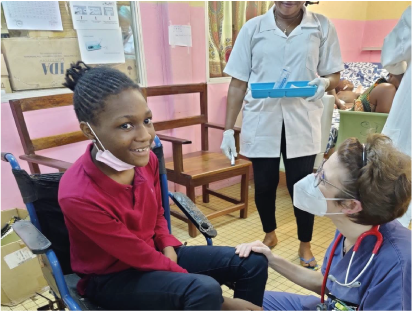Suzy, 14, is a young girl admitted to the “Soins intensifs” (intensive care) department, for severe anaemia at the Complexe Pediatrique in Bangui. Her parents had taken her to the hospital for fever, severe fatigue and the appearance of dark urine. She was very pale and could barely sit up by herself. Her haemoglobin was 3.7 g/dL, which for a girl of that age is incredibly low (normal values for that age are at least 12 g/dL). So the medical staff in charge of emergencies immediately gave a transfusion, the first of many that she received during the long three-week hospitalisation. In the first few days of hospitalisation, numerous in-depth examinations were required to understand the origin of her fever and the cause of such significant anaemia. After a few days, the result of the blood culture came back and finally the cause of the fever was discovered: an infection by a rather rare bacterium, which needed to be treated with a specific antibiotic. However, despite numerous transfusions and the start of specific cortisone-based therapy, Suzy continued to have very low haemoglobin levels.
2
The search for other available therapies began and the medical staff started to look for other available therapies, few in number given the low-resource environment. Eventually, they decided to try high-dose corticotherapy boluses and fortunately this time the therapy was successful. After two boluses Suzy gradually started to feel better, to be stronger. After almost a month of hospitalisation, fearing that she would catch hospital infections, the medical staff discharged her with a haemoglobin of 5 g/dL, with the indication to continue the cortisone at home. Yes, 5 g/dL of haemoglobin only: in other countries, for example, in Europe, it would be unthinkable to discharge a child with this value, but this is Africa. Africa means weighing the risks and benefits of each choice every day, and occasionally taking a risk. They discharged her on Saturday and she returned for a follow-up on Wednesday of the following week. She was definitely starting to feel better. Her haemoglobin continued to rise. At the next check-up after two weeks, Suzy arrived in a colourful, elegant dress, she was smiling, and she looked beautiful. She had 9.6 g/dL of haemoglobin, which was great news. She was happy because she had finally gone back to school.








